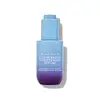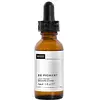What's inside
What's inside
 Key Ingredients
Key Ingredients

 Benefits
Benefits

 Concerns
Concerns

No concerns
 Ingredients Side-by-side
Ingredients Side-by-side

Water
Skin ConditioningGlycerin
HumectantPropanediol
SolventNiacinamide
SmoothingAcetyl Glycyl Beta-Alanine
Skin ConditioningAlpha-Arbutin
AntioxidantCentella Asiatica Leaf Extract
Skin ConditioningTetrapeptide-30
Skin ConditioningCopper Palmitoyl Heptapeptide-14
Skin ConditioningPalmitoyl Sh-Heptapeptide-12 Sp
Skin ConditioningTulipa Gesneriana Flower Extract
Skin ConditioningCrocus Chrysanthus Bulb Extract
Skin ConditioningGlycyrrhiza Glabra Root Extract
BleachingKinetin
Skin ConditioningIndole Acetic Acid
Skin ConditioningAvena Sativa Kernel Extract
AbrasiveCorallina Officinalis Extract
Skin ConditioningPanthenol
Skin ConditioningAllantoin
Skin ConditioningMelia Azadirachta Flower Extract
Skin ConditioningMelia Azadirachta Leaf Extract
Skin ConditioningCoccinia Indica Fruit Extract
Skin ConditioningCamellia Sinensis Leaf Extract
AntimicrobialSodium Hyaluronate
HumectantLactic Acid/Glycolic Acid Copolymer
Skin ConditioningBetaine
HumectantAcacia Senegal Gum
MaskingXanthan Gum
EmulsifyingPotassium Sorbate
PreservativeSodium Benzoate
MaskingMaltodextrin
AbsorbentCaprylyl Glycol
Emollient1,2-Hexanediol
Skin ConditioningPolyvinyl Alcohol
Sodium Hydroxide
BufferingCitric Acid
BufferingWater, Glycerin, Propanediol, Niacinamide, Acetyl Glycyl Beta-Alanine, Alpha-Arbutin, Centella Asiatica Leaf Extract, Tetrapeptide-30, Copper Palmitoyl Heptapeptide-14, Palmitoyl Sh-Heptapeptide-12 Sp, Tulipa Gesneriana Flower Extract, Crocus Chrysanthus Bulb Extract, Glycyrrhiza Glabra Root Extract, Kinetin, Indole Acetic Acid, Avena Sativa Kernel Extract, Corallina Officinalis Extract, Panthenol, Allantoin, Melia Azadirachta Flower Extract, Melia Azadirachta Leaf Extract, Coccinia Indica Fruit Extract, Camellia Sinensis Leaf Extract, Sodium Hyaluronate, Lactic Acid/Glycolic Acid Copolymer, Betaine, Acacia Senegal Gum, Xanthan Gum, Potassium Sorbate, Sodium Benzoate, Maltodextrin, Caprylyl Glycol, 1,2-Hexanediol, Polyvinyl Alcohol, Sodium Hydroxide, Citric Acid
Lentinus Edodes Mycelium Extract
Skin ConditioningWater
Skin ConditioningGlycerin
HumectantPropanediol
SolventPotassium Azeloyl Diglycinate
Skin ConditioningButylene Glycol
HumectantAcetyl Glycyl Beta-Alanine
Skin ConditioningMyristoyl Nonapeptide-3
Skin ConditioningTetrapeptide-30
Skin ConditioningOligopeptide-68
BleachingDiglucosyl Gallic Acid
Evodia Rutaecarpa Fruit Extract
Skin ConditioningAlgae Extract
EmollientGlycine Soja Oil
EmollientHydrogenated Lecithin
EmulsifyingSodium Oleate
CleansingDisodium EDTA
Trisodium Ethylenediamine Disuccinate
Pentylene Glycol
Skin ConditioningDimethyl Isosorbide
SolventEthoxydiglycol
HumectantPolysorbate 20
EmulsifyingPotassium Sorbate
PreservativeSodium Benzoate
Masking1,2-Hexanediol
Skin ConditioningPhenoxyethanol
PreservativeCaprylyl Glycol
EmollientLentinus Edodes Mycelium Extract, Water, Glycerin, Propanediol, Potassium Azeloyl Diglycinate, Butylene Glycol, Acetyl Glycyl Beta-Alanine, Myristoyl Nonapeptide-3, Tetrapeptide-30, Oligopeptide-68, Diglucosyl Gallic Acid, Evodia Rutaecarpa Fruit Extract, Algae Extract, Glycine Soja Oil, Hydrogenated Lecithin, Sodium Oleate, Disodium EDTA, Trisodium Ethylenediamine Disuccinate, Pentylene Glycol, Dimethyl Isosorbide, Ethoxydiglycol, Polysorbate 20, Potassium Sorbate, Sodium Benzoate, 1,2-Hexanediol, Phenoxyethanol, Caprylyl Glycol
 Reviews
Reviews

Ingredients Explained
These ingredients are found in both products.
Ingredients higher up in an ingredient list are typically present in a larger amount.
1,2-Hexanediol is a synthetic liquid and another multi-functional powerhouse.
It is a:
- Humectant, drawing moisture into the skin
- Emollient, helping to soften skin
- Solvent, dispersing and stabilizing formulas
- Preservative booster, enhancing the antimicrobial activity of other preservatives
We don't have a description for Acetyl Glycyl Beta-Alanine yet.
Caprylyl Glycol is a humectant and emollient, meaning it attracts and preserves moisture.
It is a common ingredient in many products, especially those designed to hydrate skin. The primary benefits are retaining moisture, skin softening, and promoting a healthy skin barrier.
Though Caprylyl Glycol is an alcohol derived from fatty acids, it is not the kind that can dry out skin.
This ingredient is also used as a preservative to extend the life of products. It has slight antimicrobial properties.
Learn more about Caprylyl GlycolGlycerin is already naturally found in your skin. It helps moisturize and protect your skin.
A study from 2016 found glycerin to be more effective as a humectant than AHAs and hyaluronic acid.
As a humectant, it helps the skin stay hydrated by pulling moisture to your skin. The low molecular weight of glycerin allows it to pull moisture into the deeper layers of your skin.
Hydrated skin improves your skin barrier; Your skin barrier helps protect against irritants and bacteria.
Glycerin has also been found to have antimicrobial and antiviral properties. Due to these properties, glycerin is often used in wound and burn treatments.
In cosmetics, glycerin is usually derived from plants such as soybean or palm. However, it can also be sourced from animals, such as tallow or animal fat.
This ingredient is organic, colorless, odorless, and non-toxic.
Glycerin is the name for this ingredient in American English. British English uses Glycerol/Glycerine.
Learn more about GlycerinPotassium Sorbate is a preservative used to prevent yeast and mold in products. It is commonly found in both cosmetic and food products.
This ingredient comes from potassium salt derived from sorbic acid. Sorbic acid is a natural antibiotic and effective against fungus.
Both potassium sorbate and sorbic acid can be found in baked goods, cheeses, dried meats, dried fruit, ice cream, pickles, wine, yogurt, and more.
You'll often find this ingredient used with other preservatives.
Learn more about Potassium SorbatePropanediol is an all-star ingredient. It softens, hydrates, and smooths the skin.
It’s often used to:
Propanediol is not likely to cause sensitivity and considered safe to use. It is derived from corn or petroleum with a clear color and no scent.
Learn more about PropanediolSodium Benzoate is a preservative. It's used in both cosmetic and food products to inhibit the growth of mold and bacteria. It is typically produced synthetically.
Both the US FDA and EU Health Committee have approved the use of sodium benzoate. In the US, levels of 0.1% (of the total product) are allowed.
Sodium benzoate works as a preservative by inhibiting the growth of bacteria inside of cells. It prevents the cell from fermenting a type of sugar using an enzyme called phosphofructokinase.
It is the salt of benzoic acid. Foods containing sodium benzoate include soda, salad dressings, condiments, fruit juices, wines, and snack foods.
Studies for using ascorbic acid and sodium benzoate in cosmetics are lacking, especially in skincare routines with multiple steps.
We always recommend speaking with a professional, such as a dermatologist, if you have any concerns.
Learn more about Sodium BenzoateTetrapeptide-30 is a synthetic peptide.
According to a manufacturer, this peptide helps with skin brightening by blocking the process of skin darkening when skin is exposed to UV.
Water. It's the most common cosmetic ingredient of all. You'll usually see it at the top of ingredient lists, meaning that it makes up the largest part of the product.
So why is it so popular? Water most often acts as a solvent - this means that it helps dissolve other ingredients into the formulation.
You'll also recognize water as that liquid we all need to stay alive. If you see this, drink a glass of water. Stay hydrated!
Learn more about Water